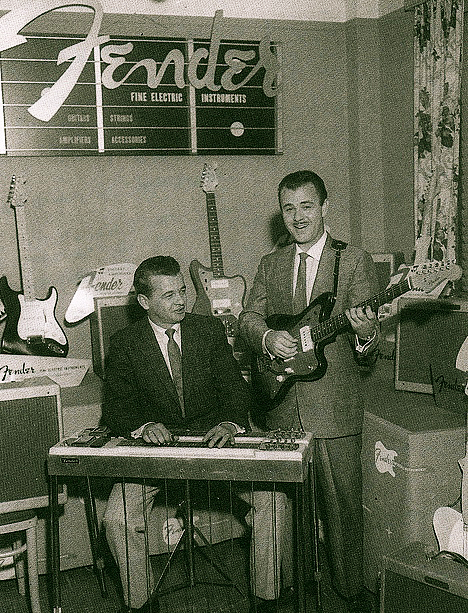Yesterday’s piece about Noel Boggs made reference to Roy Lanham, who would later play guitar in the Sons of the Pioneers to pay the bills, yet sought much more fulfilling challenges in his own music’s attempt to straddle two distinct musical styles – country and jazz – despite the frustration of being considered too country for jazz fans and too jazzy for the country crowd.
“Eager Beaver“
Roy Lanham (1958)
Roy Howard Lanham: Lead Guitar
James Leon P. ‘Jimmie‘ Widener: Rhythm Guitar
Arthur Douglas ‘Doug‘ Dalton: Mandolin
Donald ‘Dusty‘ Rhoads: Bass
Rich Kienzle, in the liner notes for the Roy Lanham two-album CD reissue for 1958’s Sizzling Strings and 1963’s The Fabulous Guitar, points out Lanham’s unique contribution that set him apart from the other country-jazz guitar giants:
The Lanham style, harmonically richer, combined both single-note passages with luxuriant chord melodies. The vibrant four-part harmonies he created for his chord solos were his own idea, an improvement upon three-part harmonies he heard Western swing guitarist Sheldon Bennett play.
This televised performance allows you to see Lanham’s complex chordal work in action:
“Lover Come Back to Me“
Roy Lanham
From Kienzle’s liner notes I learned the following fascinating facts:
− In 1943 Lanham would be drawn to Cincinnati’s 50,000-watt powerhouse, WLW, where he would work as a staff musician for the station’s various acts and later befriend Joe Maphis, Merle Travis, and Grandpa Jones. Lanham would augment his income as a staff musician by playing on King recording sessions, most notably The Delmore Brothers, with “Freight Train Boogie” being the preeminent track.
− WLW would also bring Roy Lanham together with Chet Atkins, and the two would unite in 1946 for a ‘Chester Atkins’ one-off single release, “Guitar Blues” b/w “Brown Eyes Cryin’ in the Rain,” on Nashville’s new indie label, Bullet. Says Billboard, in its Nov. 30, 1946 edition:
Majority of ‘Guitar Blues’ side allotted to guitars, with melody carried by twin guitars playing in bass and treble clef respectively. It’s a swingy, pungent side for folk music, the brief sax solo adds little.
2017 vinyl reissue –
Sundazed Music
− Roy Lanham would also replace a hot-headed Jimmy Bryant, who had stormed off Pasadena’s Hometown Jamboree television show in 1955 for the last time. Lanham would play instrumental duets from Bryant’s long-time partner, Speedy West, on “Hometown Jamboree,” but sadly, the two would never record together.
Speedy West & Roy Lanham use Fender guitars exclusively
− In 1959 Roy Lanham would overdub guitar parts onto a tape previously recorded by three Seattle high school teens, The Fleetwoods, accompanied only by car-key percussion. This song, “Come Softly to Me,” would put the tiny Dolton label on the map.
− Lanham, who had found plenty of work throughout his life as a session guitarist, once played a recording session with The Monkees. Lanham would also perform on the final album of Tex Williams before his death in 1985.
Roy Lanham
Member of The Sons of the Pioneers from 1961 through 1986
Dueling Fender guitars:
Roy Lanham’s7-string vs. Andy Tielman’s 10-string
Did You Know?
If you keyword search 78 RPM‘s catalog using the terms Roy Lanham, only four items turn up, sadly. One of the items though is the catalog record for Cowboy Copas’s October 1945 release “There Ain’t Nobody Gonna Miss Me” b/w “You Live In A World All Your Own” within which some kind soul included these recording details:
Recorded July 1945 — E. T. Herzog Studio — 811 Race St. — Cincinnati, OH.
Lloyd Estel “Cowboy” Copas (vocal, rhythm guitar), prob. Roy Lanham (lead guitar), Billy Strickland (steel guitar), and Roy Starkey (bass).
Someday I hope to hear “Lanham Git-Boogie” — the B-side of Roy Lanham’s 1950 single release for London that was issued in the US and Canada.
*
Parting Gift:
EP of Unissued Recordings for Record Store Day 2014
Treat yourself to The Spectacular Six-String Of Roy Lanham, a 4-song selection of previously unissued Roy Lanham recordings issued on Record Store Day 2014 by those fine folks at Sundazed Music.
- “My Adobe Hacienda“
- “Lanham Boogie“
- “Song of India“
- “Carnival In Paris“











2 Responses
Lanham and the Whippoorwills played (and sometimes sang) in every episode of the Smiley Burnette radio show. There are over 50 of the 12 to 14 minute shows available online.
There’s a fuzzy video with good audio on YouTube by the Whippoorwills doing “Hard Life Blues” and a portion of a Burnette show also on YouTube.
Thanking you for checking out the website and adding to the history, Tom!
Love the French beatnik attire in the “Hard Life Blues” clip – great suggestion:
https://www.youtube.com/watch?v=_v54DpZy0Bs
Fantastic example of Roy Lanham’s guitar playing.
Cheers!